Financial Accounting Report: Financial Performance Analysis
VerifiedAdded on 2021/06/15
|15
|2170
|64
Report
AI Summary
This comprehensive financial accounting report delves into key concepts and their practical applications. It begins with an analysis of Wentnor Ltd, focusing on cash-generating units and asset impairment in accordance with AASB 136. The report then assesses the financial performance of Woolsworth Group through detailed ratio analysis, including solvency, profitability, and efficiency ratios. The analysis extends to foreign exchange transactions, examining the translation of foreign currency and its impact on financial statements. Finally, the report illustrates cash flow statements using both direct and indirect methods. The report provides a thorough understanding of financial accounting principles and their application in real-world scenarios, offering valuable insights for students studying finance and accounting.
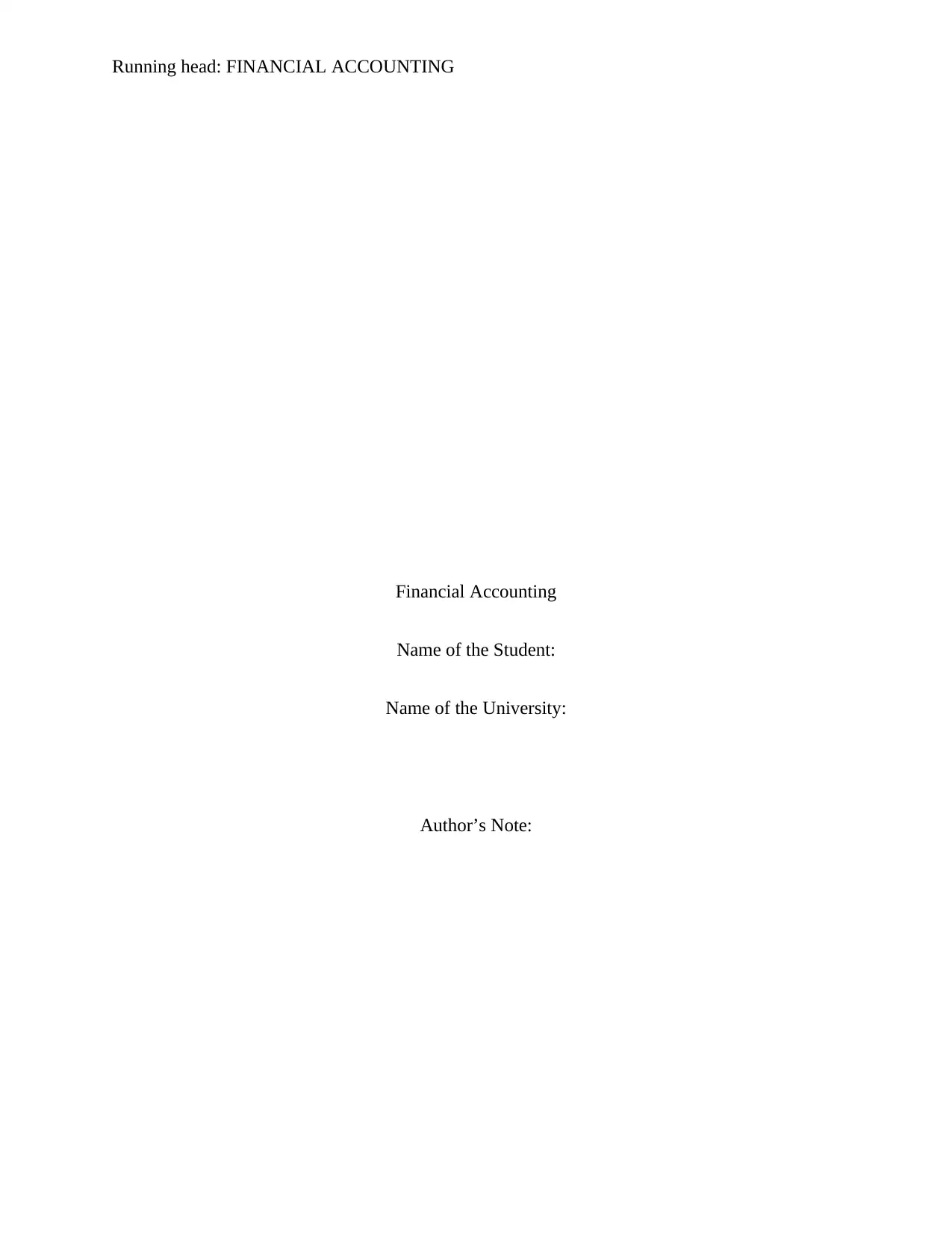
Running head: FINANCIAL ACCOUNTING
Financial Accounting
Name of the Student:
Name of the University:
Author’s Note:
Financial Accounting
Name of the Student:
Name of the University:
Author’s Note:
Paraphrase This Document
Need a fresh take? Get an instant paraphrase of this document with our AI Paraphraser
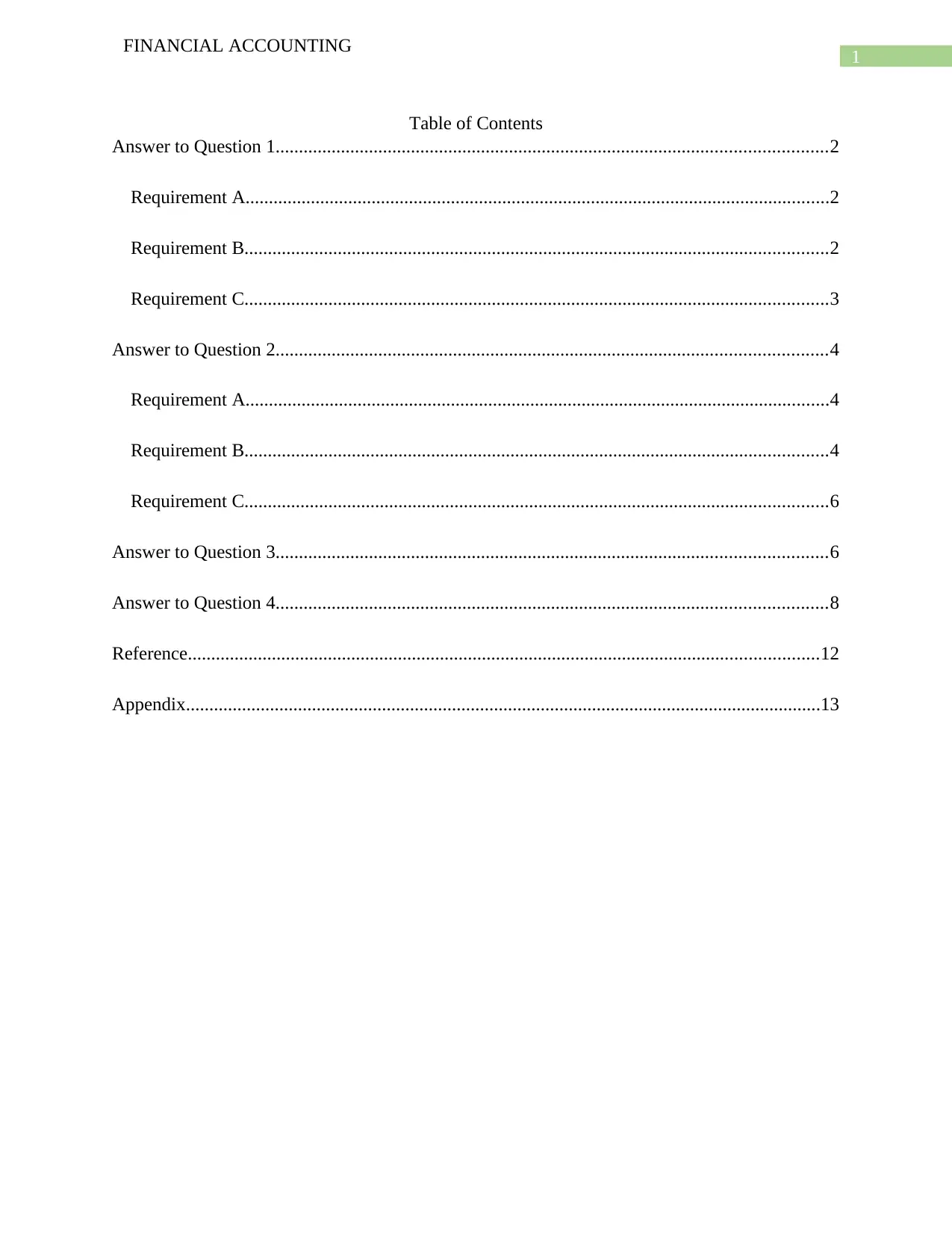
1
FINANCIAL ACCOUNTING
Table of Contents
Answer to Question 1......................................................................................................................2
Requirement A.............................................................................................................................2
Requirement B.............................................................................................................................2
Requirement C.............................................................................................................................3
Answer to Question 2......................................................................................................................4
Requirement A.............................................................................................................................4
Requirement B.............................................................................................................................4
Requirement C.............................................................................................................................6
Answer to Question 3......................................................................................................................6
Answer to Question 4......................................................................................................................8
Reference.......................................................................................................................................12
Appendix........................................................................................................................................13
FINANCIAL ACCOUNTING
Table of Contents
Answer to Question 1......................................................................................................................2
Requirement A.............................................................................................................................2
Requirement B.............................................................................................................................2
Requirement C.............................................................................................................................3
Answer to Question 2......................................................................................................................4
Requirement A.............................................................................................................................4
Requirement B.............................................................................................................................4
Requirement C.............................................................................................................................6
Answer to Question 3......................................................................................................................6
Answer to Question 4......................................................................................................................8
Reference.......................................................................................................................................12
Appendix........................................................................................................................................13
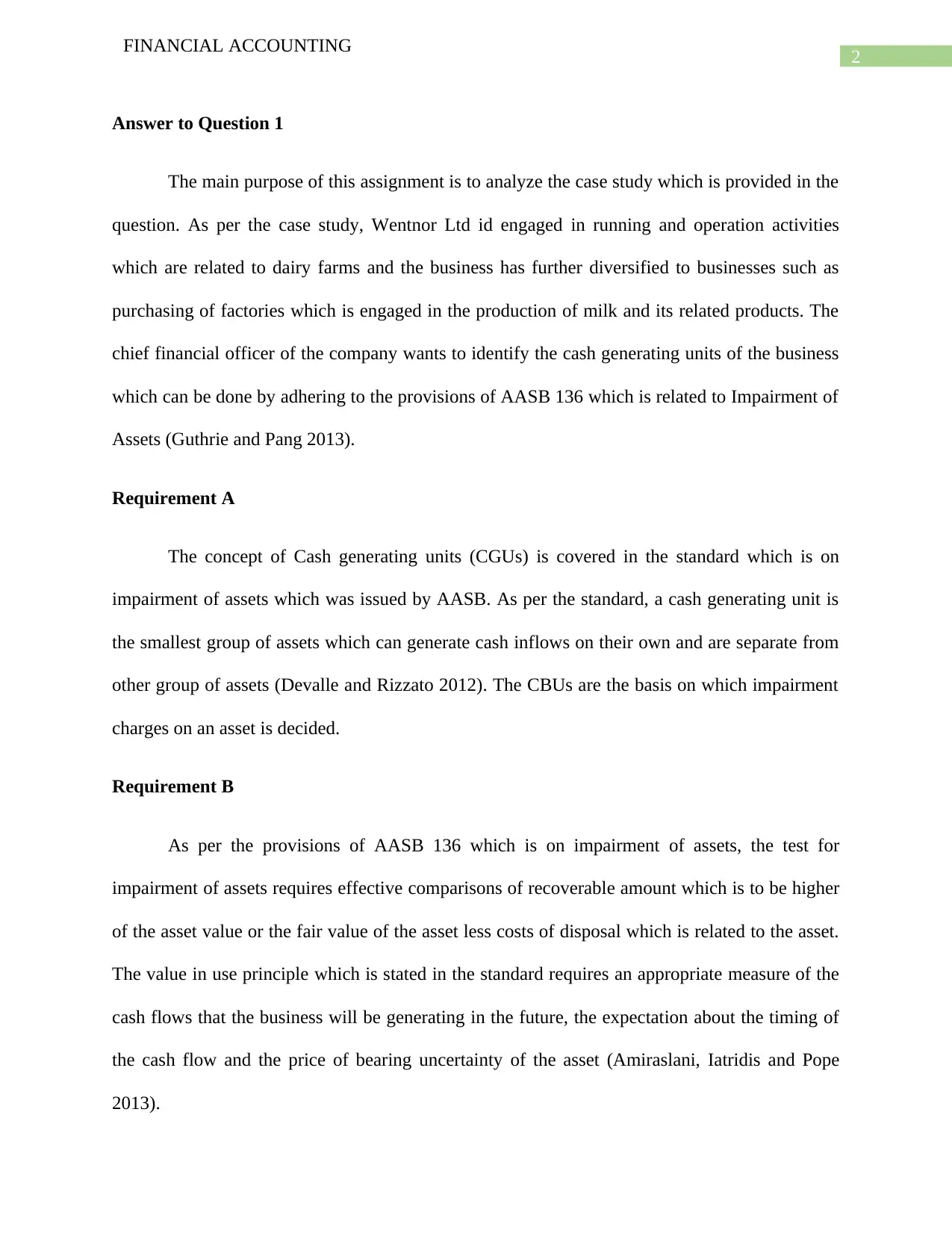
2
FINANCIAL ACCOUNTING
Answer to Question 1
The main purpose of this assignment is to analyze the case study which is provided in the
question. As per the case study, Wentnor Ltd id engaged in running and operation activities
which are related to dairy farms and the business has further diversified to businesses such as
purchasing of factories which is engaged in the production of milk and its related products. The
chief financial officer of the company wants to identify the cash generating units of the business
which can be done by adhering to the provisions of AASB 136 which is related to Impairment of
Assets (Guthrie and Pang 2013).
Requirement A
The concept of Cash generating units (CGUs) is covered in the standard which is on
impairment of assets which was issued by AASB. As per the standard, a cash generating unit is
the smallest group of assets which can generate cash inflows on their own and are separate from
other group of assets (Devalle and Rizzato 2012). The CBUs are the basis on which impairment
charges on an asset is decided.
Requirement B
As per the provisions of AASB 136 which is on impairment of assets, the test for
impairment of assets requires effective comparisons of recoverable amount which is to be higher
of the asset value or the fair value of the asset less costs of disposal which is related to the asset.
The value in use principle which is stated in the standard requires an appropriate measure of the
cash flows that the business will be generating in the future, the expectation about the timing of
the cash flow and the price of bearing uncertainty of the asset (Amiraslani, Iatridis and Pope
2013).
FINANCIAL ACCOUNTING
Answer to Question 1
The main purpose of this assignment is to analyze the case study which is provided in the
question. As per the case study, Wentnor Ltd id engaged in running and operation activities
which are related to dairy farms and the business has further diversified to businesses such as
purchasing of factories which is engaged in the production of milk and its related products. The
chief financial officer of the company wants to identify the cash generating units of the business
which can be done by adhering to the provisions of AASB 136 which is related to Impairment of
Assets (Guthrie and Pang 2013).
Requirement A
The concept of Cash generating units (CGUs) is covered in the standard which is on
impairment of assets which was issued by AASB. As per the standard, a cash generating unit is
the smallest group of assets which can generate cash inflows on their own and are separate from
other group of assets (Devalle and Rizzato 2012). The CBUs are the basis on which impairment
charges on an asset is decided.
Requirement B
As per the provisions of AASB 136 which is on impairment of assets, the test for
impairment of assets requires effective comparisons of recoverable amount which is to be higher
of the asset value or the fair value of the asset less costs of disposal which is related to the asset.
The value in use principle which is stated in the standard requires an appropriate measure of the
cash flows that the business will be generating in the future, the expectation about the timing of
the cash flow and the price of bearing uncertainty of the asset (Amiraslani, Iatridis and Pope
2013).
⊘ This is a preview!⊘
Do you want full access?
Subscribe today to unlock all pages.

Trusted by 1+ million students worldwide
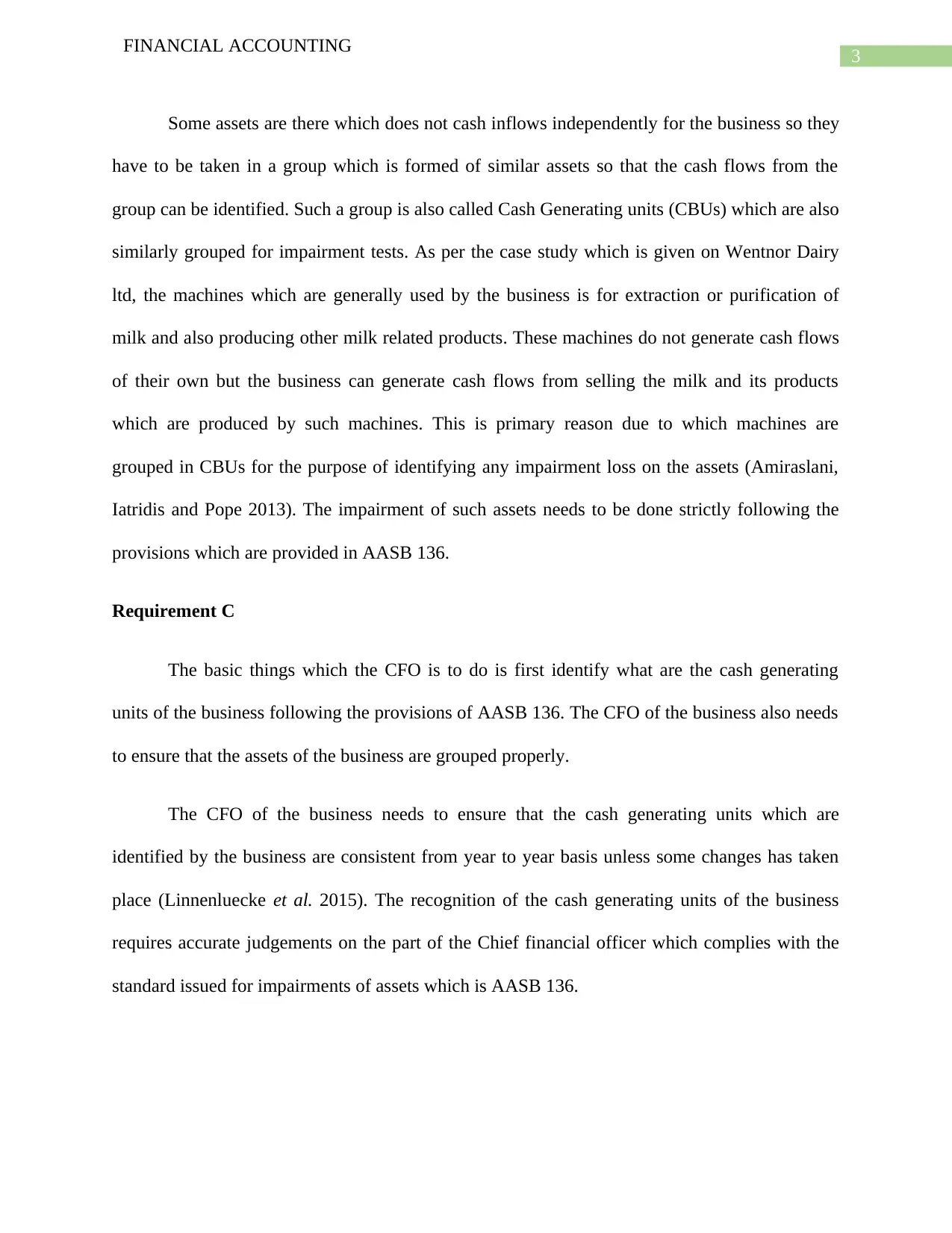
3
FINANCIAL ACCOUNTING
Some assets are there which does not cash inflows independently for the business so they
have to be taken in a group which is formed of similar assets so that the cash flows from the
group can be identified. Such a group is also called Cash Generating units (CBUs) which are also
similarly grouped for impairment tests. As per the case study which is given on Wentnor Dairy
ltd, the machines which are generally used by the business is for extraction or purification of
milk and also producing other milk related products. These machines do not generate cash flows
of their own but the business can generate cash flows from selling the milk and its products
which are produced by such machines. This is primary reason due to which machines are
grouped in CBUs for the purpose of identifying any impairment loss on the assets (Amiraslani,
Iatridis and Pope 2013). The impairment of such assets needs to be done strictly following the
provisions which are provided in AASB 136.
Requirement C
The basic things which the CFO is to do is first identify what are the cash generating
units of the business following the provisions of AASB 136. The CFO of the business also needs
to ensure that the assets of the business are grouped properly.
The CFO of the business needs to ensure that the cash generating units which are
identified by the business are consistent from year to year basis unless some changes has taken
place (Linnenluecke et al. 2015). The recognition of the cash generating units of the business
requires accurate judgements on the part of the Chief financial officer which complies with the
standard issued for impairments of assets which is AASB 136.
FINANCIAL ACCOUNTING
Some assets are there which does not cash inflows independently for the business so they
have to be taken in a group which is formed of similar assets so that the cash flows from the
group can be identified. Such a group is also called Cash Generating units (CBUs) which are also
similarly grouped for impairment tests. As per the case study which is given on Wentnor Dairy
ltd, the machines which are generally used by the business is for extraction or purification of
milk and also producing other milk related products. These machines do not generate cash flows
of their own but the business can generate cash flows from selling the milk and its products
which are produced by such machines. This is primary reason due to which machines are
grouped in CBUs for the purpose of identifying any impairment loss on the assets (Amiraslani,
Iatridis and Pope 2013). The impairment of such assets needs to be done strictly following the
provisions which are provided in AASB 136.
Requirement C
The basic things which the CFO is to do is first identify what are the cash generating
units of the business following the provisions of AASB 136. The CFO of the business also needs
to ensure that the assets of the business are grouped properly.
The CFO of the business needs to ensure that the cash generating units which are
identified by the business are consistent from year to year basis unless some changes has taken
place (Linnenluecke et al. 2015). The recognition of the cash generating units of the business
requires accurate judgements on the part of the Chief financial officer which complies with the
standard issued for impairments of assets which is AASB 136.
Paraphrase This Document
Need a fresh take? Get an instant paraphrase of this document with our AI Paraphraser
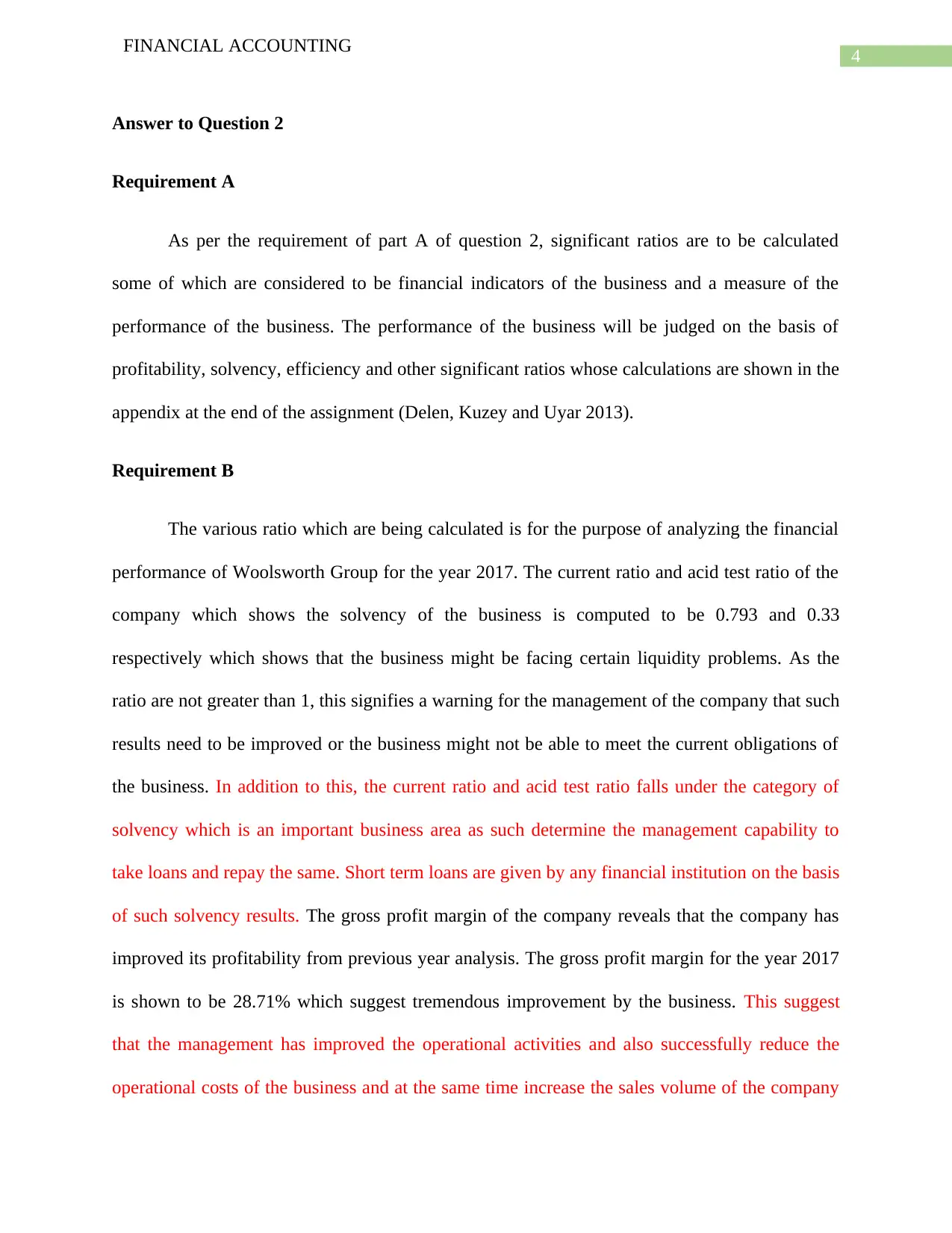
4
FINANCIAL ACCOUNTING
Answer to Question 2
Requirement A
As per the requirement of part A of question 2, significant ratios are to be calculated
some of which are considered to be financial indicators of the business and a measure of the
performance of the business. The performance of the business will be judged on the basis of
profitability, solvency, efficiency and other significant ratios whose calculations are shown in the
appendix at the end of the assignment (Delen, Kuzey and Uyar 2013).
Requirement B
The various ratio which are being calculated is for the purpose of analyzing the financial
performance of Woolsworth Group for the year 2017. The current ratio and acid test ratio of the
company which shows the solvency of the business is computed to be 0.793 and 0.33
respectively which shows that the business might be facing certain liquidity problems. As the
ratio are not greater than 1, this signifies a warning for the management of the company that such
results need to be improved or the business might not be able to meet the current obligations of
the business. In addition to this, the current ratio and acid test ratio falls under the category of
solvency which is an important business area as such determine the management capability to
take loans and repay the same. Short term loans are given by any financial institution on the basis
of such solvency results. The gross profit margin of the company reveals that the company has
improved its profitability from previous year analysis. The gross profit margin for the year 2017
is shown to be 28.71% which suggest tremendous improvement by the business. This suggest
that the management has improved the operational activities and also successfully reduce the
operational costs of the business and at the same time increase the sales volume of the company
FINANCIAL ACCOUNTING
Answer to Question 2
Requirement A
As per the requirement of part A of question 2, significant ratios are to be calculated
some of which are considered to be financial indicators of the business and a measure of the
performance of the business. The performance of the business will be judged on the basis of
profitability, solvency, efficiency and other significant ratios whose calculations are shown in the
appendix at the end of the assignment (Delen, Kuzey and Uyar 2013).
Requirement B
The various ratio which are being calculated is for the purpose of analyzing the financial
performance of Woolsworth Group for the year 2017. The current ratio and acid test ratio of the
company which shows the solvency of the business is computed to be 0.793 and 0.33
respectively which shows that the business might be facing certain liquidity problems. As the
ratio are not greater than 1, this signifies a warning for the management of the company that such
results need to be improved or the business might not be able to meet the current obligations of
the business. In addition to this, the current ratio and acid test ratio falls under the category of
solvency which is an important business area as such determine the management capability to
take loans and repay the same. Short term loans are given by any financial institution on the basis
of such solvency results. The gross profit margin of the company reveals that the company has
improved its profitability from previous year analysis. The gross profit margin for the year 2017
is shown to be 28.71% which suggest tremendous improvement by the business. This suggest
that the management has improved the operational activities and also successfully reduce the
operational costs of the business and at the same time increase the sales volume of the company
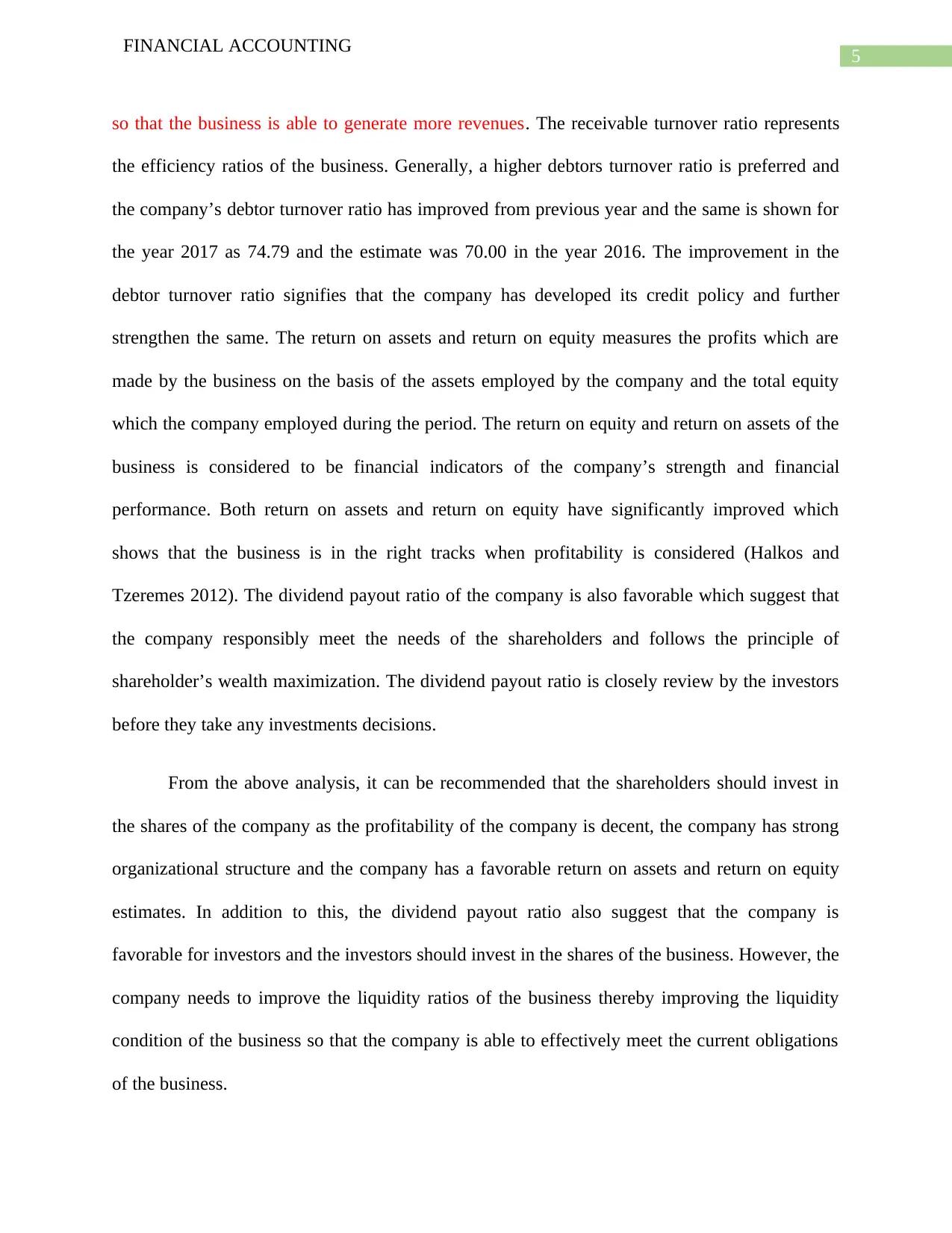
5
FINANCIAL ACCOUNTING
so that the business is able to generate more revenues. The receivable turnover ratio represents
the efficiency ratios of the business. Generally, a higher debtors turnover ratio is preferred and
the company’s debtor turnover ratio has improved from previous year and the same is shown for
the year 2017 as 74.79 and the estimate was 70.00 in the year 2016. The improvement in the
debtor turnover ratio signifies that the company has developed its credit policy and further
strengthen the same. The return on assets and return on equity measures the profits which are
made by the business on the basis of the assets employed by the company and the total equity
which the company employed during the period. The return on equity and return on assets of the
business is considered to be financial indicators of the company’s strength and financial
performance. Both return on assets and return on equity have significantly improved which
shows that the business is in the right tracks when profitability is considered (Halkos and
Tzeremes 2012). The dividend payout ratio of the company is also favorable which suggest that
the company responsibly meet the needs of the shareholders and follows the principle of
shareholder’s wealth maximization. The dividend payout ratio is closely review by the investors
before they take any investments decisions.
From the above analysis, it can be recommended that the shareholders should invest in
the shares of the company as the profitability of the company is decent, the company has strong
organizational structure and the company has a favorable return on assets and return on equity
estimates. In addition to this, the dividend payout ratio also suggest that the company is
favorable for investors and the investors should invest in the shares of the business. However, the
company needs to improve the liquidity ratios of the business thereby improving the liquidity
condition of the business so that the company is able to effectively meet the current obligations
of the business.
FINANCIAL ACCOUNTING
so that the business is able to generate more revenues. The receivable turnover ratio represents
the efficiency ratios of the business. Generally, a higher debtors turnover ratio is preferred and
the company’s debtor turnover ratio has improved from previous year and the same is shown for
the year 2017 as 74.79 and the estimate was 70.00 in the year 2016. The improvement in the
debtor turnover ratio signifies that the company has developed its credit policy and further
strengthen the same. The return on assets and return on equity measures the profits which are
made by the business on the basis of the assets employed by the company and the total equity
which the company employed during the period. The return on equity and return on assets of the
business is considered to be financial indicators of the company’s strength and financial
performance. Both return on assets and return on equity have significantly improved which
shows that the business is in the right tracks when profitability is considered (Halkos and
Tzeremes 2012). The dividend payout ratio of the company is also favorable which suggest that
the company responsibly meet the needs of the shareholders and follows the principle of
shareholder’s wealth maximization. The dividend payout ratio is closely review by the investors
before they take any investments decisions.
From the above analysis, it can be recommended that the shareholders should invest in
the shares of the company as the profitability of the company is decent, the company has strong
organizational structure and the company has a favorable return on assets and return on equity
estimates. In addition to this, the dividend payout ratio also suggest that the company is
favorable for investors and the investors should invest in the shares of the business. However, the
company needs to improve the liquidity ratios of the business thereby improving the liquidity
condition of the business so that the company is able to effectively meet the current obligations
of the business.
⊘ This is a preview!⊘
Do you want full access?
Subscribe today to unlock all pages.

Trusted by 1+ million students worldwide
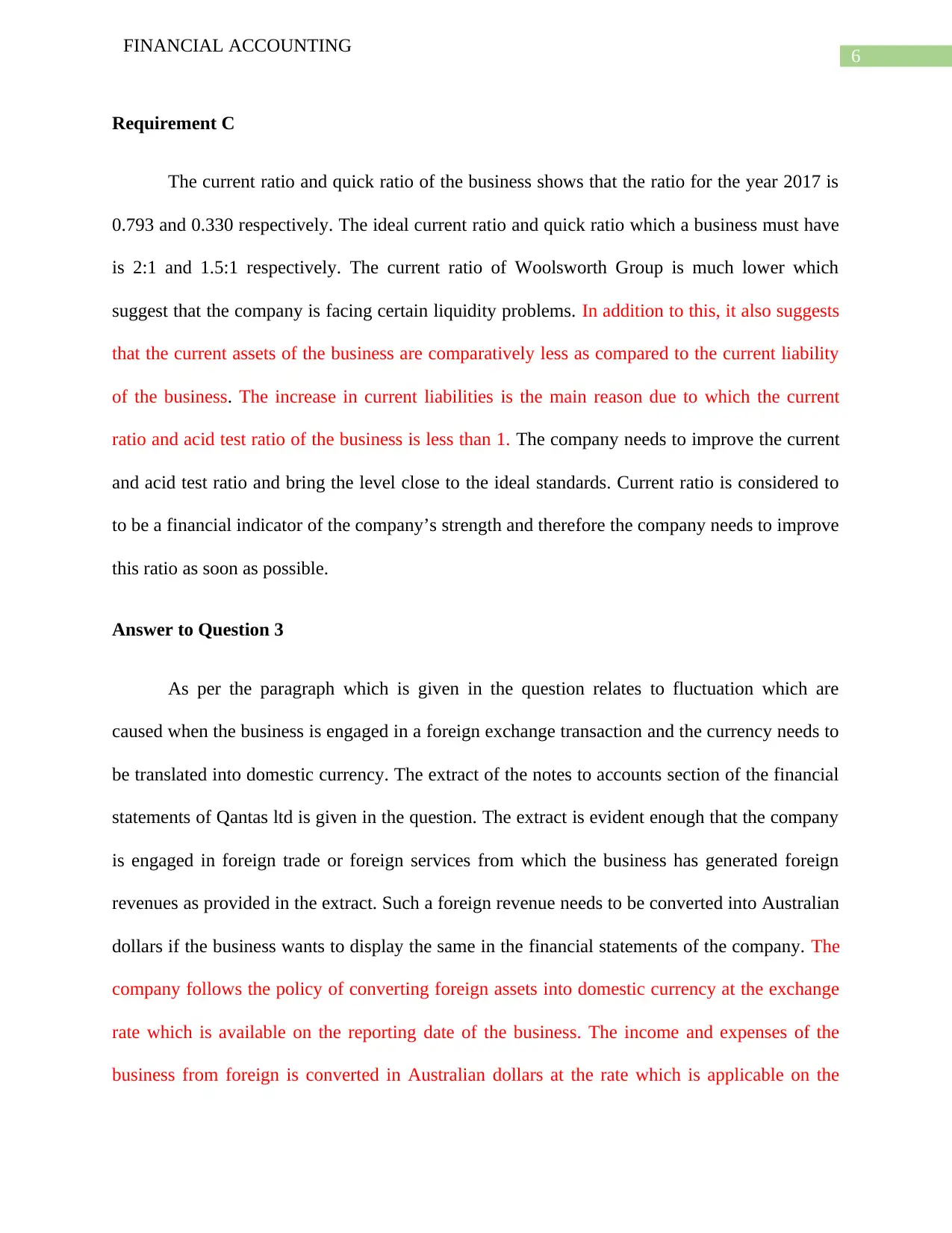
6
FINANCIAL ACCOUNTING
Requirement C
The current ratio and quick ratio of the business shows that the ratio for the year 2017 is
0.793 and 0.330 respectively. The ideal current ratio and quick ratio which a business must have
is 2:1 and 1.5:1 respectively. The current ratio of Woolsworth Group is much lower which
suggest that the company is facing certain liquidity problems. In addition to this, it also suggests
that the current assets of the business are comparatively less as compared to the current liability
of the business. The increase in current liabilities is the main reason due to which the current
ratio and acid test ratio of the business is less than 1. The company needs to improve the current
and acid test ratio and bring the level close to the ideal standards. Current ratio is considered to
to be a financial indicator of the company’s strength and therefore the company needs to improve
this ratio as soon as possible.
Answer to Question 3
As per the paragraph which is given in the question relates to fluctuation which are
caused when the business is engaged in a foreign exchange transaction and the currency needs to
be translated into domestic currency. The extract of the notes to accounts section of the financial
statements of Qantas ltd is given in the question. The extract is evident enough that the company
is engaged in foreign trade or foreign services from which the business has generated foreign
revenues as provided in the extract. Such a foreign revenue needs to be converted into Australian
dollars if the business wants to display the same in the financial statements of the company. The
company follows the policy of converting foreign assets into domestic currency at the exchange
rate which is available on the reporting date of the business. The income and expenses of the
business from foreign is converted in Australian dollars at the rate which is applicable on the
FINANCIAL ACCOUNTING
Requirement C
The current ratio and quick ratio of the business shows that the ratio for the year 2017 is
0.793 and 0.330 respectively. The ideal current ratio and quick ratio which a business must have
is 2:1 and 1.5:1 respectively. The current ratio of Woolsworth Group is much lower which
suggest that the company is facing certain liquidity problems. In addition to this, it also suggests
that the current assets of the business are comparatively less as compared to the current liability
of the business. The increase in current liabilities is the main reason due to which the current
ratio and acid test ratio of the business is less than 1. The company needs to improve the current
and acid test ratio and bring the level close to the ideal standards. Current ratio is considered to
to be a financial indicator of the company’s strength and therefore the company needs to improve
this ratio as soon as possible.
Answer to Question 3
As per the paragraph which is given in the question relates to fluctuation which are
caused when the business is engaged in a foreign exchange transaction and the currency needs to
be translated into domestic currency. The extract of the notes to accounts section of the financial
statements of Qantas ltd is given in the question. The extract is evident enough that the company
is engaged in foreign trade or foreign services from which the business has generated foreign
revenues as provided in the extract. Such a foreign revenue needs to be converted into Australian
dollars if the business wants to display the same in the financial statements of the company. The
company follows the policy of converting foreign assets into domestic currency at the exchange
rate which is available on the reporting date of the business. The income and expenses of the
business from foreign is converted in Australian dollars at the rate which is applicable on the
Paraphrase This Document
Need a fresh take? Get an instant paraphrase of this document with our AI Paraphraser
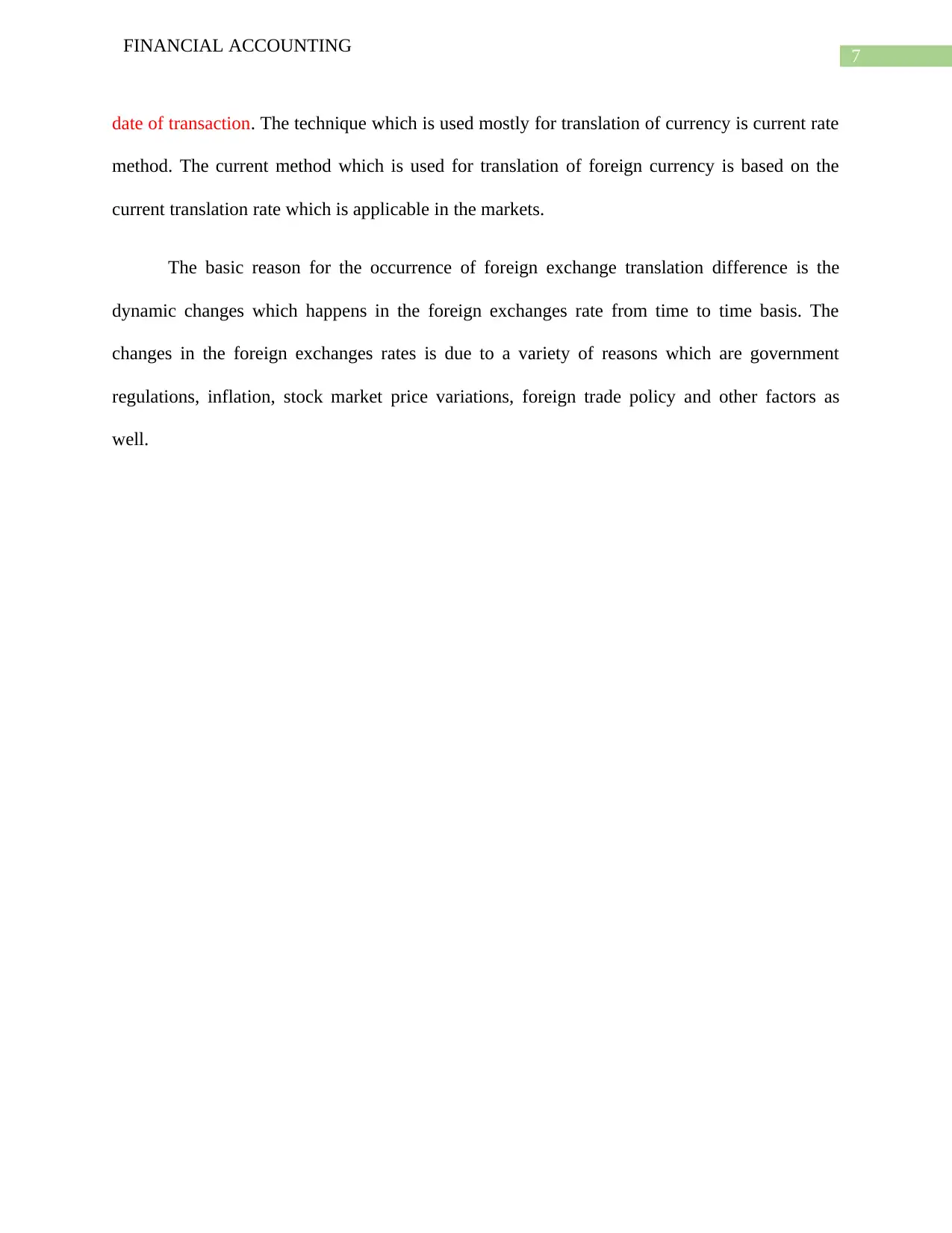
7
FINANCIAL ACCOUNTING
date of transaction. The technique which is used mostly for translation of currency is current rate
method. The current method which is used for translation of foreign currency is based on the
current translation rate which is applicable in the markets.
The basic reason for the occurrence of foreign exchange translation difference is the
dynamic changes which happens in the foreign exchanges rate from time to time basis. The
changes in the foreign exchanges rates is due to a variety of reasons which are government
regulations, inflation, stock market price variations, foreign trade policy and other factors as
well.
FINANCIAL ACCOUNTING
date of transaction. The technique which is used mostly for translation of currency is current rate
method. The current method which is used for translation of foreign currency is based on the
current translation rate which is applicable in the markets.
The basic reason for the occurrence of foreign exchange translation difference is the
dynamic changes which happens in the foreign exchanges rate from time to time basis. The
changes in the foreign exchanges rates is due to a variety of reasons which are government
regulations, inflation, stock market price variations, foreign trade policy and other factors as
well.
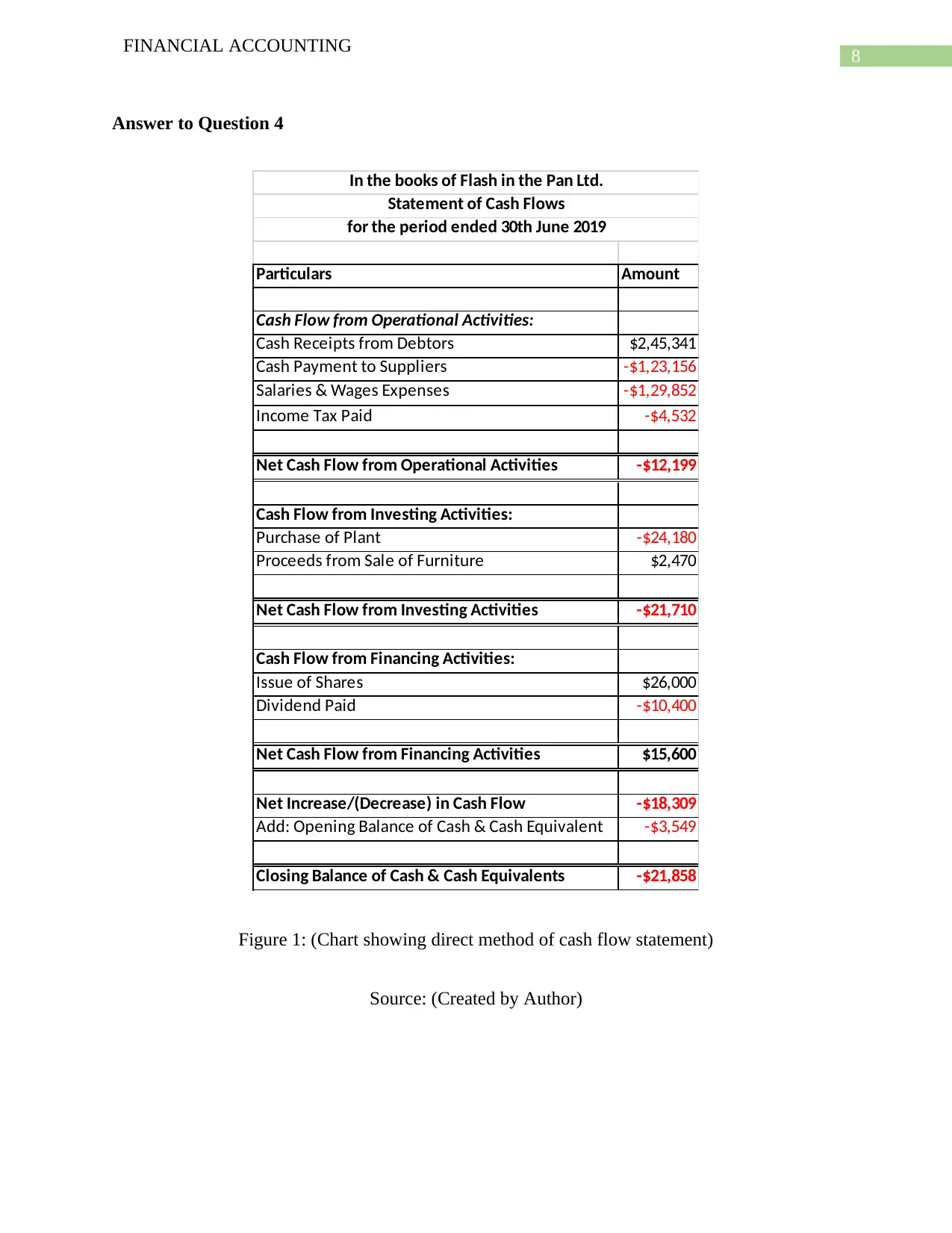
8
FINANCIAL ACCOUNTING
Answer to Question 4
Particulars Amount
Cash Flow from Operational Activities:
Cash Receipts from Debtors $2,45,341
Cash Payment to Suppliers -$1,23,156
Salaries & Wages Expenses -$1,29,852
Income Tax Paid -$4,532
Net Cash Flow from Operational Activities -$12,199
Cash Flow from Investing Activities:
Purchase of Plant -$24,180
Proceeds from Sale of Furniture $2,470
Net Cash Flow from Investing Activities -$21,710
Cash Flow from Financing Activities:
Issue of Shares $26,000
Dividend Paid -$10,400
Net Cash Flow from Financing Activities $15,600
Net Increase/(Decrease) in Cash Flow -$18,309
Add: Opening Balance of Cash & Cash Equivalent -$3,549
Closing Balance of Cash & Cash Equivalents -$21,858
In the books of Flash in the Pan Ltd.
Statement of Cash Flows
for the period ended 30th June 2019
Figure 1: (Chart showing direct method of cash flow statement)
Source: (Created by Author)
FINANCIAL ACCOUNTING
Answer to Question 4
Particulars Amount
Cash Flow from Operational Activities:
Cash Receipts from Debtors $2,45,341
Cash Payment to Suppliers -$1,23,156
Salaries & Wages Expenses -$1,29,852
Income Tax Paid -$4,532
Net Cash Flow from Operational Activities -$12,199
Cash Flow from Investing Activities:
Purchase of Plant -$24,180
Proceeds from Sale of Furniture $2,470
Net Cash Flow from Investing Activities -$21,710
Cash Flow from Financing Activities:
Issue of Shares $26,000
Dividend Paid -$10,400
Net Cash Flow from Financing Activities $15,600
Net Increase/(Decrease) in Cash Flow -$18,309
Add: Opening Balance of Cash & Cash Equivalent -$3,549
Closing Balance of Cash & Cash Equivalents -$21,858
In the books of Flash in the Pan Ltd.
Statement of Cash Flows
for the period ended 30th June 2019
Figure 1: (Chart showing direct method of cash flow statement)
Source: (Created by Author)
⊘ This is a preview!⊘
Do you want full access?
Subscribe today to unlock all pages.

Trusted by 1+ million students worldwide
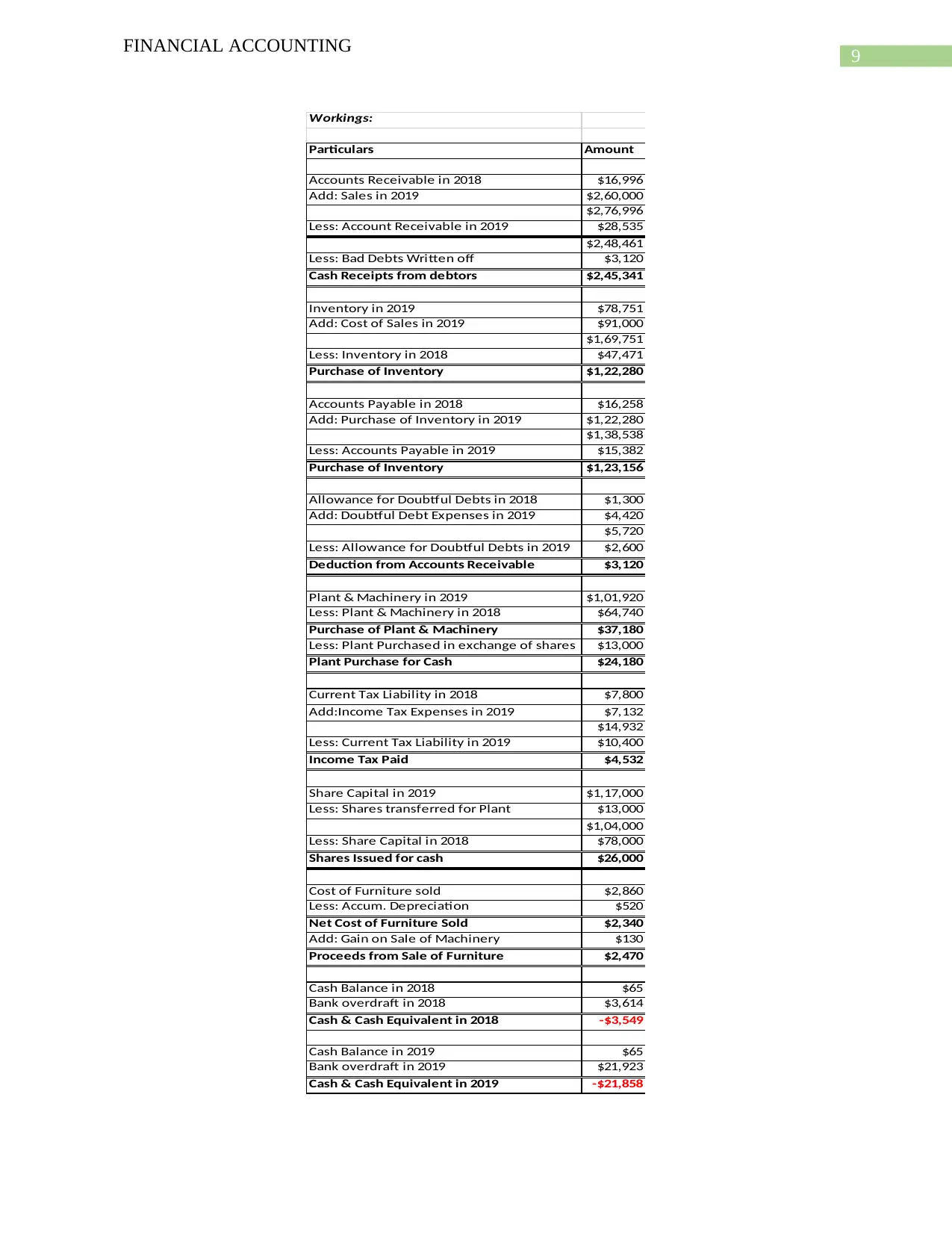
9
FINANCIAL ACCOUNTING
Workings:
Particulars Amount
Accounts Receivable in 2018 $16,996
Add: Sales in 2019 $2,60,000
$2,76,996
Less: Account Receivable in 2019 $28,535
$2,48,461
Less: Bad Debts Written off $3,120
Cash Receipts from debtors $2,45,341
Inventory in 2019 $78,751
Add: Cost of Sales in 2019 $91,000
$1,69,751
Less: Inventory in 2018 $47,471
Purchase of Inventory $1,22,280
Accounts Payable in 2018 $16,258
Add: Purchase of Inventory in 2019 $1,22,280
$1,38,538
Less: Accounts Payable in 2019 $15,382
Purchase of Inventory $1,23,156
Allowance for Doubtful Debts in 2018 $1,300
Add: Doubtful Debt Expenses in 2019 $4,420
$5,720
Less: Allowance for Doubtful Debts in 2019 $2,600
Deduction from Accounts Receivable $3,120
Plant & Machinery in 2019 $1,01,920
Less: Plant & Machinery in 2018 $64,740
Purchase of Plant & Machinery $37,180
Less: Plant Purchased in exchange of shares $13,000
Plant Purchase for Cash $24,180
Current Tax Liability in 2018 $7,800
Add:Income Tax Expenses in 2019 $7,132
$14,932
Less: Current Tax Liability in 2019 $10,400
Income Tax Paid $4,532
Share Capital in 2019 $1,17,000
Less: Shares transferred for Plant $13,000
$1,04,000
Less: Share Capital in 2018 $78,000
Shares Issued for cash $26,000
Cost of Furniture sold $2,860
Less: Accum. Depreciation $520
Net Cost of Furniture Sold $2,340
Add: Gain on Sale of Machinery $130
Proceeds from Sale of Furniture $2,470
Cash Balance in 2018 $65
Bank overdraft in 2018 $3,614
Cash & Cash Equivalent in 2018 -$3,549
Cash Balance in 2019 $65
Bank overdraft in 2019 $21,923
Cash & Cash Equivalent in 2019 -$21,858
FINANCIAL ACCOUNTING
Workings:
Particulars Amount
Accounts Receivable in 2018 $16,996
Add: Sales in 2019 $2,60,000
$2,76,996
Less: Account Receivable in 2019 $28,535
$2,48,461
Less: Bad Debts Written off $3,120
Cash Receipts from debtors $2,45,341
Inventory in 2019 $78,751
Add: Cost of Sales in 2019 $91,000
$1,69,751
Less: Inventory in 2018 $47,471
Purchase of Inventory $1,22,280
Accounts Payable in 2018 $16,258
Add: Purchase of Inventory in 2019 $1,22,280
$1,38,538
Less: Accounts Payable in 2019 $15,382
Purchase of Inventory $1,23,156
Allowance for Doubtful Debts in 2018 $1,300
Add: Doubtful Debt Expenses in 2019 $4,420
$5,720
Less: Allowance for Doubtful Debts in 2019 $2,600
Deduction from Accounts Receivable $3,120
Plant & Machinery in 2019 $1,01,920
Less: Plant & Machinery in 2018 $64,740
Purchase of Plant & Machinery $37,180
Less: Plant Purchased in exchange of shares $13,000
Plant Purchase for Cash $24,180
Current Tax Liability in 2018 $7,800
Add:Income Tax Expenses in 2019 $7,132
$14,932
Less: Current Tax Liability in 2019 $10,400
Income Tax Paid $4,532
Share Capital in 2019 $1,17,000
Less: Shares transferred for Plant $13,000
$1,04,000
Less: Share Capital in 2018 $78,000
Shares Issued for cash $26,000
Cost of Furniture sold $2,860
Less: Accum. Depreciation $520
Net Cost of Furniture Sold $2,340
Add: Gain on Sale of Machinery $130
Proceeds from Sale of Furniture $2,470
Cash Balance in 2018 $65
Bank overdraft in 2018 $3,614
Cash & Cash Equivalent in 2018 -$3,549
Cash Balance in 2019 $65
Bank overdraft in 2019 $21,923
Cash & Cash Equivalent in 2019 -$21,858
Paraphrase This Document
Need a fresh take? Get an instant paraphrase of this document with our AI Paraphraser
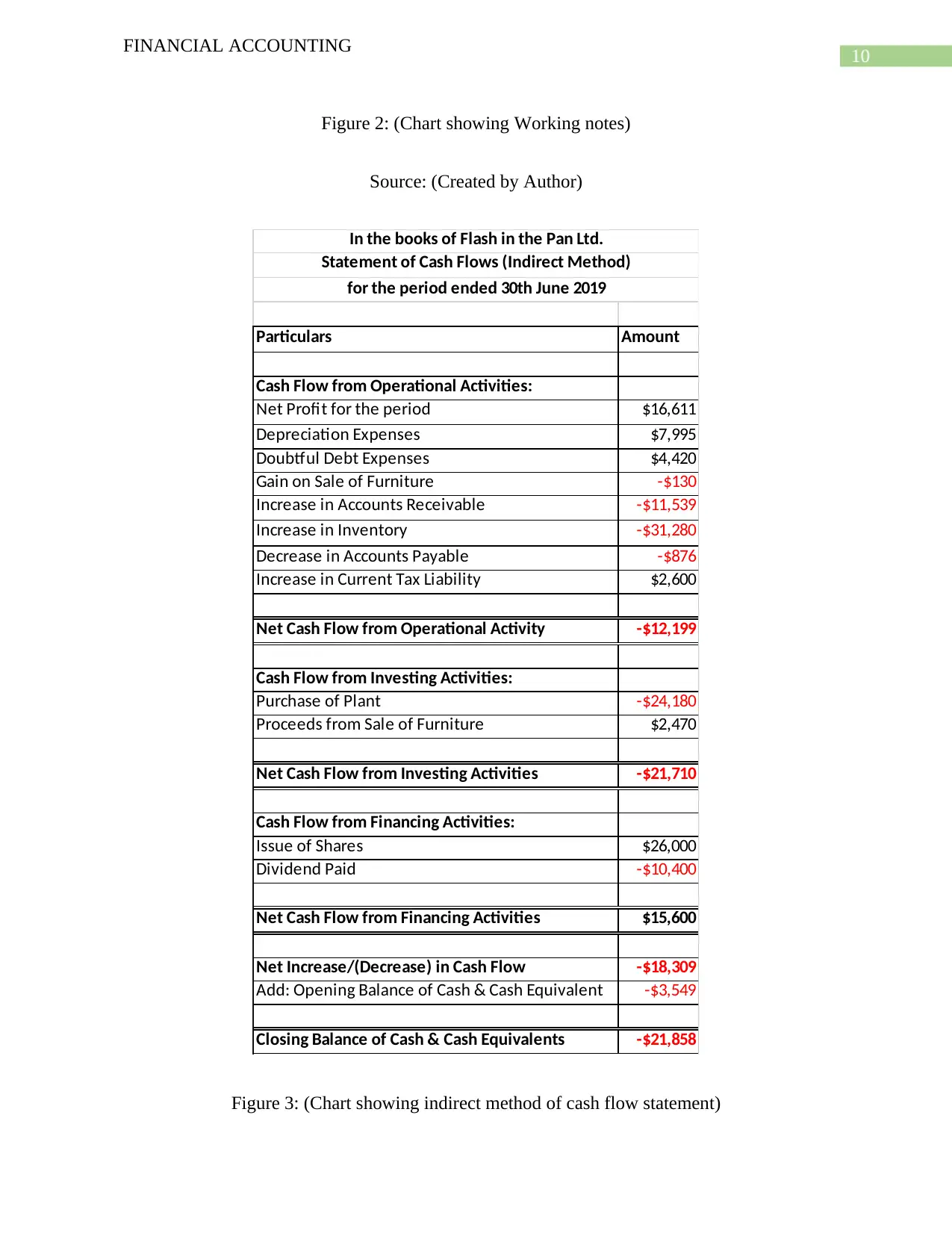
10
FINANCIAL ACCOUNTING
Figure 2: (Chart showing Working notes)
Source: (Created by Author)
Particulars Amount
Cash Flow from Operational Activities:
Net Profit for the period $16,611
Depreciation Expenses $7,995
Doubtful Debt Expenses $4,420
Gain on Sale of Furniture -$130
Increase in Accounts Receivable -$11,539
Increase in Inventory -$31,280
Decrease in Accounts Payable -$876
Increase in Current Tax Liability $2,600
Net Cash Flow from Operational Activity -$12,199
Cash Flow from Investing Activities:
Purchase of Plant -$24,180
Proceeds from Sale of Furniture $2,470
Net Cash Flow from Investing Activities -$21,710
Cash Flow from Financing Activities:
Issue of Shares $26,000
Dividend Paid -$10,400
Net Cash Flow from Financing Activities $15,600
Net Increase/(Decrease) in Cash Flow -$18,309
Add: Opening Balance of Cash & Cash Equivalent -$3,549
Closing Balance of Cash & Cash Equivalents -$21,858
In the books of Flash in the Pan Ltd.
Statement of Cash Flows (Indirect Method)
for the period ended 30th June 2019
Figure 3: (Chart showing indirect method of cash flow statement)
FINANCIAL ACCOUNTING
Figure 2: (Chart showing Working notes)
Source: (Created by Author)
Particulars Amount
Cash Flow from Operational Activities:
Net Profit for the period $16,611
Depreciation Expenses $7,995
Doubtful Debt Expenses $4,420
Gain on Sale of Furniture -$130
Increase in Accounts Receivable -$11,539
Increase in Inventory -$31,280
Decrease in Accounts Payable -$876
Increase in Current Tax Liability $2,600
Net Cash Flow from Operational Activity -$12,199
Cash Flow from Investing Activities:
Purchase of Plant -$24,180
Proceeds from Sale of Furniture $2,470
Net Cash Flow from Investing Activities -$21,710
Cash Flow from Financing Activities:
Issue of Shares $26,000
Dividend Paid -$10,400
Net Cash Flow from Financing Activities $15,600
Net Increase/(Decrease) in Cash Flow -$18,309
Add: Opening Balance of Cash & Cash Equivalent -$3,549
Closing Balance of Cash & Cash Equivalents -$21,858
In the books of Flash in the Pan Ltd.
Statement of Cash Flows (Indirect Method)
for the period ended 30th June 2019
Figure 3: (Chart showing indirect method of cash flow statement)
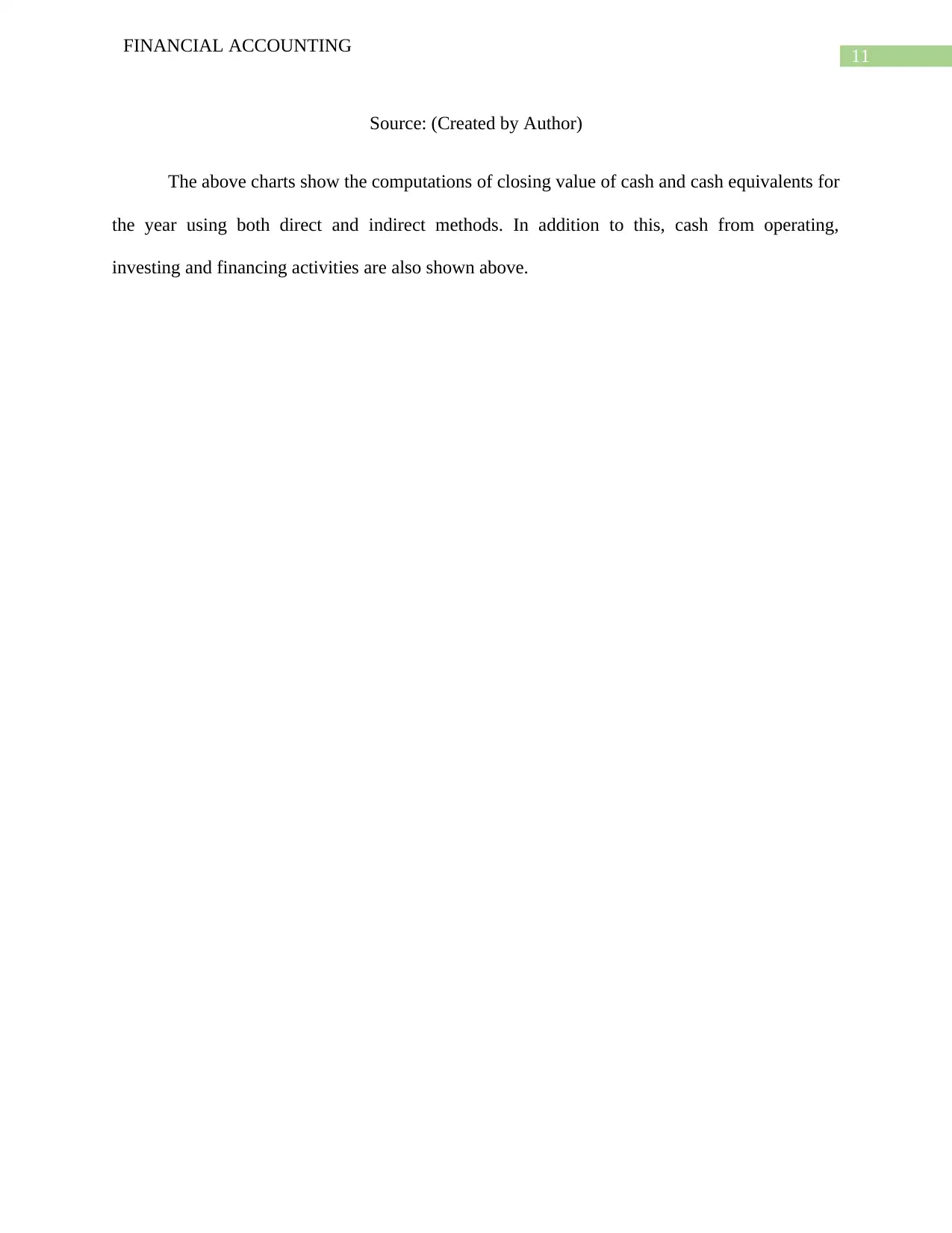
11
FINANCIAL ACCOUNTING
Source: (Created by Author)
The above charts show the computations of closing value of cash and cash equivalents for
the year using both direct and indirect methods. In addition to this, cash from operating,
investing and financing activities are also shown above.
FINANCIAL ACCOUNTING
Source: (Created by Author)
The above charts show the computations of closing value of cash and cash equivalents for
the year using both direct and indirect methods. In addition to this, cash from operating,
investing and financing activities are also shown above.
⊘ This is a preview!⊘
Do you want full access?
Subscribe today to unlock all pages.

Trusted by 1+ million students worldwide
1 out of 15
Related Documents
Your All-in-One AI-Powered Toolkit for Academic Success.
+13062052269
info@desklib.com
Available 24*7 on WhatsApp / Email
![[object Object]](/_next/static/media/star-bottom.7253800d.svg)
Unlock your academic potential
Copyright © 2020–2025 A2Z Services. All Rights Reserved. Developed and managed by ZUCOL.




